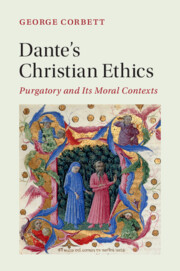Book contents
- Dante’s Christian Ethics
- Cambridge Studies in Medieval Literature
- Dante’s Christian Ethics
- Copyright page
- Contents
- Acknowledgements
- Editions Followed and Abbreviations
- Introduction
- Part I Ethical and Political Manifesto
- Part II Reframing Dante’s Christian Ethics
- Part III Penance and Dante’s Purgatory
- Chapter 5 The Terrace of Pride, and the Poet As Preacher
- Chapter 6 The Terrace of Sloth, and the Sin of Scholars
- Chapter 7 The Terrace of Avarice, and the Love of Children
- Conclusion
- Bibliography
- Index
- Cambridge Studies in Medieval Literature
Chapter 7 - The Terrace of Avarice, and the Love of Children
from Part III - Penance and Dante’s Purgatory
Published online by Cambridge University Press: 28 February 2020
- Dante’s Christian Ethics
- Cambridge Studies in Medieval Literature
- Dante’s Christian Ethics
- Copyright page
- Contents
- Acknowledgements
- Editions Followed and Abbreviations
- Introduction
- Part I Ethical and Political Manifesto
- Part II Reframing Dante’s Christian Ethics
- Part III Penance and Dante’s Purgatory
- Chapter 5 The Terrace of Pride, and the Poet As Preacher
- Chapter 6 The Terrace of Sloth, and the Sin of Scholars
- Chapter 7 The Terrace of Avarice, and the Love of Children
- Conclusion
- Bibliography
- Index
- Cambridge Studies in Medieval Literature
Summary
Critics have typically failed to appreciate the importance of the sin of sloth in Dante’s biography, as well as its pervasive presence in his Christian moral vision. This chapter demonstrates that Peraldus’s treatise ‘De acedia’ profoundly influenced Dante’s poetic representation of sloth. It opens up the depth and breadth of contemporary understandings of acedia enabling us to understand sloth as, indeed, a scholar and a poet’s sin.
Two key narrative dramas occur in the terrace of sloth: the acute fervour of the penitent slothful and, framing this, Dante-character’s intellectual zeal for knowledge. Virgil’s three doctrinal lectures (XVII, 73– XVIII, 87) – on the moral structure of Purgatory, on the nature of love, and on free will and moral responsibility – are not, then, parenthetical to the terrace’s drama. Rather, they are represented symbolically by the dream of the Siren (XVIII, 130–45 and XIX, 1–69).
Dante’s first sin in Inferno I may be identified as tepidity and, more precisely, as the sub-vice of ignavia. Likewise, Dante’s confession in the Earthly Paradise is principally a sin of omission, with the Siren’s call providing a psychological dichotomy with the desire for Beatrice. Sloth is also the post-conversion sin of Statius, Dante’s poetic cypher.
- Type
- Chapter
- Information
- Dante's Christian EthicsPurgatory and Its Moral Contexts, pp. 166 - 203Publisher: Cambridge University PressPrint publication year: 2020



